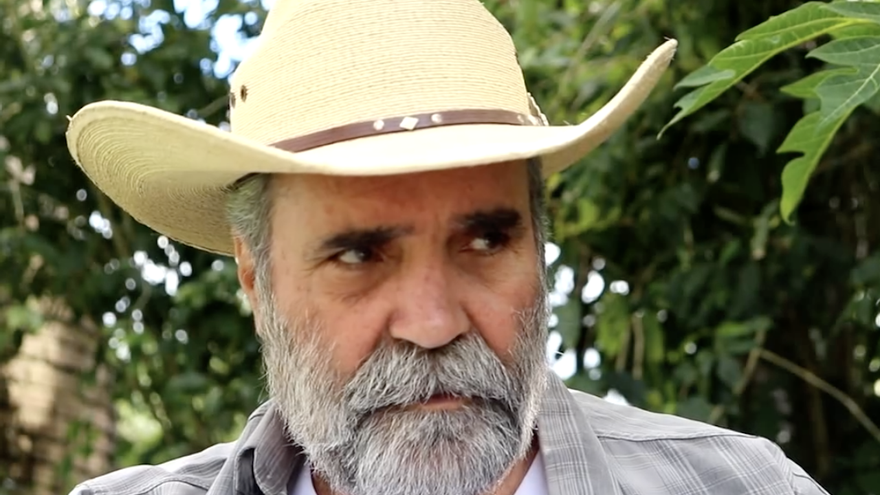
![]() 14ymedio, Havana, 5 February 2024 — With milk at 20 pesos, “I have to sell 4.5 gallons to make a dollar,” and the transport to take it to the destination costs the equivalent of 6.6 gallons, says rancher José A. Casimiro, owner of the Finca del Medio, in Siguaney (Sancti Spíritus), where he practices agroecology and permaculture. In a brief interview on Facebook, he describes the desperate situation of Cuban farmers in the face of the siege of the bureaucracy and the lack of decision by the authorities.
14ymedio, Havana, 5 February 2024 — With milk at 20 pesos, “I have to sell 4.5 gallons to make a dollar,” and the transport to take it to the destination costs the equivalent of 6.6 gallons, says rancher José A. Casimiro, owner of the Finca del Medio, in Siguaney (Sancti Spíritus), where he practices agroecology and permaculture. In a brief interview on Facebook, he describes the desperate situation of Cuban farmers in the face of the siege of the bureaucracy and the lack of decision by the authorities.
The prices of milk and cattle are almost humiliating for the small farmer, he adds. “Where in the world do you find milk with that value? In addition to the cost of transport, to take it to the State collection centers, which is 500 pesos. That means that just to cover the cost of transporting milk you have to sell almost seven gallons.”
Casimiro explains that there is no way to make a profit, either by selling the animal or by selling the milk. The State buys a bull of 1,000 pounds, after the animal has been fattened for two or three years, with all the expenses (transport, health, taxes and travel to do paperwork) and implications for its commercialization, for less than what a 47-pound piglet costs. The farmer ends up receiving the equivalent of 47 dollars for such an animal, at 14 pesos per pound. “Where is the profitability?” he asks.
The ranchers continue to be threatened by excessive controls, low prices and the obligation to sell a good part of their productions to the State
The rancher says that he has been in the same circumstances and conditions for 30 years, facing bureaucratic obstacles and fighting against the lack of serious decisions for the development of the countryside and productive opportunities that allow the upward social mobility of Cuban farmers. “If I buy an 11-ounce tin of canned meat [in foreign exchange stores], it costs [the equivalent of] 500 pesos. It is not possible to develop agriculture, livestock or tobacco, under these conditions. This system has been broken for so long, and I don’t see the light,” he concludes.
That reality largely explains the deficit of 29 million gallons of milk with which the sector closed 2023 on the Island. For the official press, the problem lies in those responsible for the dairy industry, but as Casimiro explains, it is the underlying structure. Farmers continue to be tied up by excessive controls, low prices and the obligation to sell a good part of their productions to the State.
Marina, a 61-year-old woman who receives milk on a medical diet, said “the situation is even more serious than the authorities reveal… They create the illusion that they are handing out milk when in reality they are giving us only a drop. To top it off, milk is getting more and more watered down. You put it on the stove and it doesn’t boil. It evaporates because of the water.”
Another citizen echoed the complaints that suggest that “they are adding cassava flour to the milk. I don’t know what they are mixing it with, but my wife and I decided not to buy it anymore,” despite the need. “I won’t risk giving that to my children.”
Meanwhile, the Ministry of Agriculture ordered the cessation of transactions of purchase and sale of livestock from February 15, with exceptions of slaughters authorized for emergency health reasons or for sale to the State. The regime intends to start on March 1 a “special control” to quantify the existing head of livestock in the country and thus “have a characterization of the current situation of the livestock sector in Cuba.”
According to official figures, there are more than 200,000 people, natural and legal, who own cattle and buffalo, and about 167,000 who have horses. The last Statistical Yearbook, published in 2023 with the data from 2022, indicated the existence of 947,300 head of horses on the Island and 3,516,400 of cattle, which contrasts with the 6,000,000 that were counted in 1958. This year’s census is not any better than that of 2023.
Translated by Regina Anavy
___________________
COLLABORATE WITH OUR WORK: The 14ymedio team is committed to practicing serious journalism that reflects Cuba’s reality in all its depth. Thank you for joining us on this long journey. We invite you to continue supporting us by becoming a member of 14ymedio now. Together we can continue transforming journalism in Cuba.
